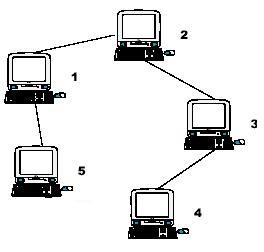hdoj - 2196 - Computer
来源:互联网 发布:mysql保存特殊字符 编辑:程序博客网 时间:2024/04/28 21:44
Computer
Time Limit: 1000/1000 MS (Java/Others) Memory Limit: 32768/32768 K (Java/Others)Total Submission(s): 2963 Accepted Submission(s): 1503
Problem Description
A school bought the first computer some time ago(so this computer's id is 1). During the recent years the school bought N-1 new computers. Each new computer was connected to one of settled earlier. Managers of school are anxious about slow functioning of the net and want to know the maximum distance Si for which i-th computer needs to send signal (i.e. length of cable to the most distant computer). You need to provide this information.

Hint: the example input is corresponding to this graph. And from the graph, you can see that the computer 4 is farthest one from 1, so S1 = 3. Computer 4 and 5 are the farthest ones from 2, so S2 = 2. Computer 5 is the farthest one from 3, so S3 = 3. we also get S4 = 4, S5 = 4.

Hint: the example input is corresponding to this graph. And from the graph, you can see that the computer 4 is farthest one from 1, so S1 = 3. Computer 4 and 5 are the farthest ones from 2, so S2 = 2. Computer 5 is the farthest one from 3, so S3 = 3. we also get S4 = 4, S5 = 4.
Input
Input file contains multiple test cases.In each case there is natural number N (N<=10000) in the first line, followed by (N-1) lines with descriptions of computers. i-th line contains two natural numbers - number of computer, to which i-th computer is connected and length of cable used for connection. Total length of cable does not exceed 10^9. Numbers in lines of input are separated by a space.
Output
For each case output N lines. i-th line must contain number Si for i-th computer (1<=i<=N).
Sample Input
51 12 13 11 1
Sample Output
32344
Author
scnu
求每个点到叶子节点的最大距离。
如果转化成一颗有根数,那么最长距离只可能来自于到子树叶节点或者父节点的最大距离加上该节点到父节点的距离。
先一遍dfs求出每个点到子节点的最大距离及次大距离,之所以求次大距离是因为如果父节点的最大距离路径恰好经过当前节点,那么父节点加的就是次短路径。再一遍DFS即可
#include<iostream>#include<cstdio>#include<cstring>#include<algorithm>#include<cmath>#include<vector>#include<map>using namespace std;const int N = 10010;struct edge{ int to, val;}e;vector<edge> G[N];int vis[N];int maxn[N];int smaxn[N];int maxid[N];int smaxid[N];int res[N];int n;void dfs1(int x){ int len = G[x].size(); for(int i = 0; i < len; i++){ if(!vis[G[x][i].to]){ vis[G[x][i].to] = 1; dfs1(G[x][i].to); int t1 = G[x][i].to; if(smaxn[x] < maxn[t1] + G[x][i].val){ smaxn[x] = maxn[t1] + G[x][i].val; smaxid[x] = t1; if(smaxn[x] > maxn[x]){ swap(smaxn[x], maxn[x]); swap(smaxid[x], maxid[x]); } } } }}void dfs2(int x){ int len = G[x].size(); for(int i = 0; i < len; i++){ int g = G[x][i].to; if(!vis[g]){ vis[g] = 1; if(g == maxid[x]) res[g] = max(res[x], smaxn[x]) + G[x][i].val; else res[g] = max(res[x], maxn[x]) + G[x][i].val; dfs2(g); } }}int main(){ while(scanf("%d", &n) != EOF){ for(int i = 0; i <= n; i++) G[i].clear(); for(int i = 2; i <= n; i++){ scanf("%d%d", &e.to, &e.val); G[i].push_back(e); int tmp = e.to; e.to = i; G[tmp].push_back(e); } memset(vis, 0, sizeof(vis)); memset(maxn, 0, sizeof(maxn)); memset(smaxn, 0, sizeof(smaxn)); memset(maxid, 0, sizeof(maxid)); memset(smaxid, 0, sizeof(smaxid)); vis[1] = 1; dfs1(1); memset(res, 0, sizeof(res)); memset(vis, 0, sizeof(vis)); vis[1] = 1; dfs2(1); for(int i = 1; i <= n; i++) printf("%d\n", max(maxn[i], res[i])); } return 0;} 0 0
- HDOJ 2196 Computer
- HDOJ 2196 Computer
- hdoj - 2196 - Computer
- HDOJ 2196 Computer
- HDOJ-2196 Computer
- hdoj 2196Computer 树形DP
- computer hdoj 2196树形dp
- HDOJ 2196 Computer (经典题)
- HDOJ 2196 Computer 树的直径
- hdoj 2196 Computer 树形dp经典题
- HDOJ 1041 Computer Transformation
- HDOJ-1041-Computer Transformation
- hdoj 1041 Computer Tranformation
- HDOJ 1041 Computer Transformation
- HDOJ题目2196 Computer(树的直径)
- HDOJ HDU 1041 Computer Transformation
- hdoj 2196 Computer 【树的直径 求每个点的最长路】
- Hdoj 5154 Harry and Magical Computer 【拓扑】
- 新的开始
- 在我们的现代生活方式高清网络摄像机的意义
- Swift语言官方文档翻译(6)-Collection Types
- BASE64java 常用 加密方法
- 关于博客中的126相册图片不显示的问题
- hdoj - 2196 - Computer
- Windows Azure微软免费云空间成功申请和使用教程:安装WP博客
- 自家电脑搭建服务器可能遇到的问题及解决方法
- Linux文件共享(四)——父进程与子进程之间的文件共享
- 游标的灵活运用
- Java 返回文件名字,不加后缀
- js 判断页面是第一次加载
- javaBean方式将不含时分秒的日期格式插入oracle数据库
- 《古剑奇谭》席卷暑期档 张檬挑战霸气御姐


